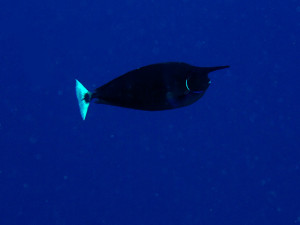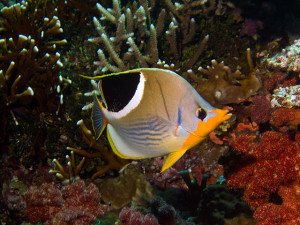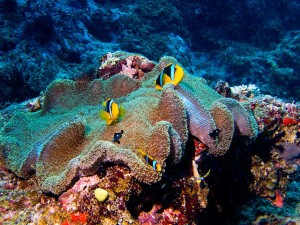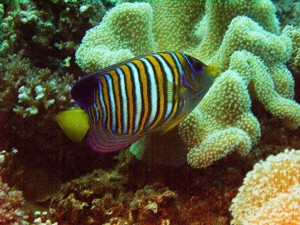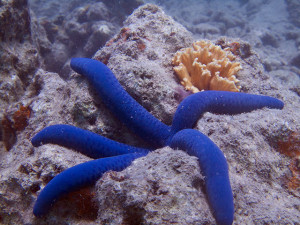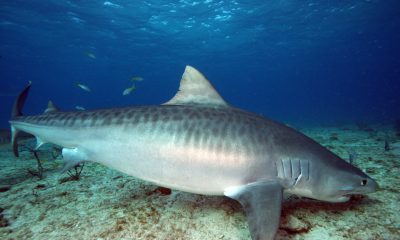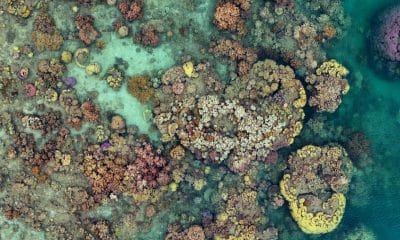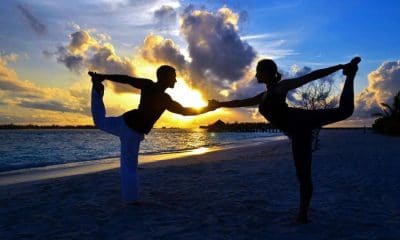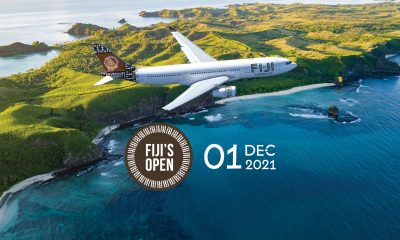Travel Stories
Diving Fiji from Wananavu Beach Resort

The mere mention of Fiji brings to mind beauty above and below water – tropical islands scented with fragrant blossoms and the sound of rustling palm fronds. Divers have seen photographs and video, heard stories from friends of spectacular soft corals and brilliantly colored fish. As with most divers, Fiji was high on our “must-dive list”. It is a long trip however, that carries you across the International Date Line. Under most circumstances we would have opted for a liveaboard in order to maximize diving and then spent a few days on land. In this particular case though, we could not extend our trip and therefore elected to do a land-based resort. We took the recommendation for Wananavu Beach Resort and found it to be an utterly delightful experience.
If one wishes to discuss practical matters first, Wananavu is located on Viti Levu, Fiji’s main island, approximately 2.5 hours drive north from the Nadi airport. The distance allows you to see the small villages and much of the varied terrain as you drive slowly behind trailers bearing sugarcane or perhaps stop to allow livestock to be herded across the two-lane road. It became apparent that the idea of getting a car and exploring the countryside on our own in that part of the island would require both a four-wheel drive vehicle and a definite sense of adventure. The resort has a number of excursions that guests can take to local sites. We were not able to avail ourselves because of the timing of the dives, but if you have non-divers along or a “down day”, that would be the chance to check out the famous “Cannibal King’s” village.
As for the diving, managers Chris and Victoria Liles operate the in-house Dive Wananavu, a fully functioning dive operation with rental equipment, nitrox, and PADI instruction available. The gear storage area by the lagoon is nicely arranged and it is only steps to the boat dock and the two custom-built dive boats, Nami (Japanese for Wave) and the smaller Nami Lailai. Chris and Victoria’s goal is a simple one and that is, “To provide a land-based operation, with the feel of a liveaboard.”
From the moment you turn your gear over to one of the dive staff, you know you are in the hands of people who want to share their passion for diving. While the boats are rated for 18 and 8 people respectively, they try to keep them at a maximum of 16 divers (more commonly 14 though) and 6 divers respectively. The boats can make the run to the Vatu-I-Ra passage in approximately an hour and there are numerous other sites closer to the resort. As you plunge into the water of whichever site is selected, you quickly understand why this area is referred to as “the soft coral capital of the world”. On one particular site, “Wheatfield”, the mass of golden-colored coral swaying does indeed look like its namesake. There were so many clownfish of all sizes darting in and out that it was not possible to count them all. And as popular as little “Nemos” are, the spectacular colors of the angel and butterfly fish catch your eye with each vivid flash that passes you. Not that my husband, the photographer, didn’t appreciate them, but he was busy capturing pipe fish as often as he could and beautiful nudibranchs. Black-tip and white-tip sharks tended not to linger once we entered the water, usually gliding away within a few minutes.
Aside from seeing banner fish, unicorn fish, and a wide variety of angel and butterfly fish, there were many species that we never did identify nor capture in photo. One was particularly intriguing and another diver told us that we’d seen a dart fish as we described the peculiar shape. In addition to fabulous marine life and underwater topography, most of the sites were simple to navigate as they were pinnacles in one shape or the other and visibility ranged from 70-100+ feet. The pinnacles allowed for multi-level diving with plenty to see during the safety stop. Current was mild to moderate, only strong on the first day at one site.
We had both been keeping a very hectic schedule for months and made the decision to dive each morning and snorkel in the afternoon after a leisurely al fresco or beachside lunch. Shore diving is also available although the visibility at the resort itself is only approximately 20-25 feet. Despite that, there are lovely blue starfish and other marine life as well as easy access for getting in and out of the water. Snorkeling happened to work better for us even though several guests enjoyed the shore diving (Okay, the snorkeling part may have had to do with the leisurely lunch including cold beer).
As wonderful as the diving is, the resort is designed for relaxation and was exactly the kind of place that we needed. There are no telephones or televisions in the rooms and the internet is extremely limited. The idea of coming to Wananavu is to unplug and unwind.
The buildings are arranged in a tiered fashion with the lobby, gift shop, restaurant and bar at the top of the property to give a panoramic view across the water. The pool, complete with man-made waterfall, is the next level down with a path that winds to the far side to take you to the small spa area. When you book a bure (room), you can opt for garden, partial ocean view, or beachside. Native hardwoods are used throughout and with a small balcony off our partial ocean view room, we would sit at night and watch glittering stars as we listened to the slap of waves against the sand below us. The beach sand is groomed daily and the sunrises and sunsets are lovely. The birdlife is plentiful among the familiar tropical offerings of hibiscus, bougainvillea, and other flowering shrubs that I wasn’t familiar with.
It does take a few strolls along the foliaged-lined paths to become properly oriented and at the very lowest level to the left is the lagoon with the dive shop, boats, another beach area, and beach café that is open for part of the day. There was in fact, a black seahorse that had been resident in the lagoon for a while, but it had disappeared a day or two before we arrived.
Fijians are known for their hospitality and warmth and that was reflected among the entire staff. The food plan at the resort includes a large continental breakfast as well as cook to order if you wish. The two course lunch menu provides sandwiches, soups, entrees and desserts and it is expanded to three courses for dinner. Alcoholic beverages are an additional cost and there is a full bar service. There is a buffet every few nights and one night is usually devoted to a “Fijian Lovo” which features traditional cooking and later a “Meke” – story-telling through dance. A local trio provides music each afternoon and evening though and the “kava bowl” is available if you wish to try this regional beverage made from the roots of the kava plants. I confess that we did not choose to partake, although we most assuredly enjoyed the local beer, rum, and of course Australian and New Zealand wines.
If you plan to attend DEMA in Orlando in November 2013, you can stop by the Dive Wananavu booth and meet the Liles in person. Or you can log onto http://www.DiveWananavuFiji.com and access their Facebook Page at http://www.Facebook.com/DiveWananavuFiji.com for more information and blog posts.
Blogs
Northern Red Sea Reefs and Wrecks Trip Report, Part 3: The Mighty Thistlegorm

Jake Davies boards Ghazala Explorer for an unforgettable Red Sea diving experience…
Overnight, the wind picked up, making the planned morning dive a bit bumpy on the Zodiacs to the drop point on Thomas Reef. There, we would dive along the reef before descending through the canyon and then passing under the arch before ascending the wall with a gentle drift. The site provided great encounters with more pelagic species, including shoals of large barracuda, tuna, and bigeye trevally.
Once back on the boat, it was time to get everything tied down again as we would head back south. This time, with the wind behind us, heading to Ras Mohammed to dive Jackfish Alley for another great gentle drift wall dive before then heading up the coast towards the Gulf of Suez to moor up at the wreck of the Thistlegorm. This being the highlight wreck dive of the trip and for many onboard, including myself, it was the first time diving this iconic wreck. I had heard so much about the wreck from friends, and globally, this is a must on any diver’s list. Fortunately for us, there was only one other boat at the site, which was a rarity. A great briefing was delivered by Ahmed, who provided a detailed background about the wreck’s history along with all the required safety information as the currents and visibility at the site can be variable.

Kitting up, there was a lot of excitement on deck before entering the water and heading down the shoreline. Descending to the wreck, there was a light northerly current which reduced the visibility, making it feel more like the conditions that can be found off the Welsh coast. At 10m from the bottom, the outline of the wreck appeared as we reached the area of the wreck which had been bombed, as our mooring line was attached to part of the propeller shaft. Arriving on deck, instantly everywhere you looked there were many of the supplies which the ship was carrying, including Bren Carrier tanks and projectiles that instantly stood out.

We headed around the exterior, taking a look at the large propeller and guns mounted on deck before entering the wreck on the port side to take a look in the holds. It was incredible to see all the trucks, Norton 16H, and BSA motorcycles still perfectly stacked within, providing a real snapshot in time.

Overall, we had four dives on the Thistlegorm, where for all of the dives we were the only group in the water, and at times, there were just three of us on the whole wreck, which made it even more special, especially knowing that most days the wreck has hundreds of divers. Along with the history of the wreck, there was plenty of marine life on the wreck and around, from big green turtles to batfish, along with shoals of mackerel being hunted by trevally. Some unforgettable dives.

The final leg of the trip saw us cross back over the Suez Canal to the Gobal Islands where we planned to stay the night and do three dives at the Dolphin House for the potential of sharing the dive with dolphins. The site, which included a channel that was teeming with reef fish, especially large numbers of goatfish that swam in large shoals along the edge of the reef. These were nice relaxing dives to end the week. Unfortunately, the dolphins didn’t show up, which was okay as like all marine life they are difficult to predict and you can’t guarantee what’s going to be seen. With the last dive complete, we headed back to port for the final night where it was time to clean all the kit and pack before the departure flight the next day.

The whole week from start to finish on Ghazala Explorer was amazing; the boat had all the facilities you need for a comfortable week aboard. The crew were always there to help throughout the day and the chefs providing top quality food which was required after every dive. The itinerary providing some of the best diving with a nice mixture of wreck and reef dives. I would recommend the trip to anyone, whether it’s your first Red Sea liveaboard in the Red Sea or you’re revisiting. Hopefully, it’s not too long before I head back to explore more of the Red Sea onboard Ghazala Explorer.

To find out more about the Northern Red Sea reef and wrecks itineraries aboard Ghazala Explorer, or to book, contact Scuba Travel now:
Email: dive@scubatravel.com
Tel: +44 (0)1483 411590
Photos: Jake Davies / Avalon.Red
Blogs
Northern Red Sea Reefs and Wrecks Trip Report, Part 2: Wall to Wall Wrecks

Jake Davies boards Ghazala Explorer for an unforgettable Red Sea diving experience…
The second day’s diving was a day full of wreck diving at Abu Nuhas, which included the Chrisoula K, Carnatic, and Ghiannis D. The first dive of the day was onto the Chrisoula K, also known as the wreck of tiles. The 98m vessel remains largely intact where she was loaded with tiles which can be seen throughout the hold. The stern sits at 26m and the bow just below the surface. One of the highlights of the wreck is heading inside and seeing the workroom where the machinery used for cutting the tiles are perfectly intact. The bow provided some relaxing scenery as the bright sunlight highlighted the colours of the soft coral reef and the many reef fish.

Following breakfast, we then headed to the next wreck, which was the Carnatic. The Carnatic is an 89.9m sail steamer vessel that was built in Britain back in 1862. She ran aground on the reef back in 1869 and remains at 27m. At the time, she was carrying a range of items, including 40,000 sterling in gold. An impressive wreck where much of the superstructure remains, and the two large masts lay on the seafloor. The wooden ribs of the hull provide structures for lots of soft corals, and into the stern section, the light beams through, bouncing off the large shoals of glass fish that can be found using the structure as shelter from the larger predators that are found outside of the wreck.

The final wreck at Abu Nuhas was the Ghiannis D, originally called ‘Shoyo Maru,’ which was 99.5m long and built in Japan back in 1969 before becoming a Greek-registered cargo ship in 1980. The ship then ran aground on the reef on April 19th, 1983, and now sits at the bottom at a depth of 27m. Heading down the line, the stern of the ship remains in good condition compared to the rest of the hull. The highlight of the wreck, though, is heading into the stern section and down the flights of stairs to enter the engine room, which remains in good condition and is definitely worth exploring. After exploring the interior section of the ship, we then headed over to see the rest of the superstructure, where it’s particularly interesting to see the large table corals that have grown at the bow relatively quickly considering the date the ship sank. After surfacing and enjoying some afternoon snacks, we made sure everything was strapped down and secured as we would be heading north and crossing the Gulf of Suez, where the winds were still creating plenty of chop.

The next morning, it was a short hop to Ras Mohammed Nature Reserve for the next couple of days of diving. The 6am wake-up call came along with the briefing for the first site we would be diving, which was Shark & Yolanda. The low current conditions allowed us to start the dive at Anemone City, where we would drift along the steep, coral-filled wall. These dives involved drifts, as mooring in Ras Mohammed wasn’t allowed to protect the reefs. As a dive site, Shark & Yolanda is well-known and historically had a lot of sharks, but unfortunately not so many in recent years, especially not so early in the season. However, there was always a chance when looking out into the blue.

The gentle drift took us along the steep walls of the site, with plenty of anemone fish to be seen and a huge variety of corals. It wasn’t long into the dive before we were accompanied by a hawksbill turtle, who drifted with us between the two atolls before parting ways. Between the two reefs, the shallow patch with parts of coral heads surrounded by sand provided the chance to see a few blue-spotted stingrays that were mainly resting underneath the corals and are always a pleasure to see. With this being the morning dive, the early sunlight lit up the walls, providing tranquil moments. Looking out into the blue, there was very little to be seen, but a small shoal of batfish shimmering underneath the sunlight was a moment to capture as we watched them swim by as they watched us.

Towards the end of the dive, we stopped at the wreck of the Jolanda where the seafloor was scattered with toilets from the containers it was carrying. This provided a unique site to make a safety stop, which was also accompanied by a large barracuda slowly swimming by, along with a hawksbill turtle calmly swimming over the reef as the sun rays danced in the distance.
For the next dive, we headed north to the Strait of Tiran to explore the reefs situated between Tiran Island and Sharm El Sheik, which were named after the British divers who had found them. We started on Jackson before heading to Gordons Reef, where we also did the night dive. All the atolls at these sites provided stunning, bustling coral reefs close to the surface and steep walls to swim along, which always provided the opportunity to keep an eye out for some of the larger species that can be seen in the blue. Midwater around Jackson Reef was filled with red-toothed triggerfish and shoals of banner fish, which at times were so dense that you couldn’t see into the blue. Moments went by peacefully as we enjoyed the slow drift above the reef, watching these shoals swim around under the mid-afternoon sun.

The night dive at Gordon’s Reef was mainly among the stacks of corals surrounded by sand, which was great to explore under the darkness. After some time circling the corals, we came across what we were really hoping to find, and that was an octopus hunting on the reef. We spent the majority of the dive just watching it crawl among the reef, blending into its changing surroundings through changes in colour and skin texture. It’s always so fascinating and captivating to watch these incredibly intelligent animals, in awe of their ability to carry out these physical changes to perfectly blend into the reef. Before we knew it, it was time to head back to the boat to enjoy a well-deserved tasty dinner prepared by the talented chefs onboard.
Check in for the 3rd and final part of this series from Jake tomorrow!
To find out more about the Northern Red Sea reef and wrecks itineraries aboard Ghazala Explorer, or to book, contact Scuba Travel now:
Email: dive@scubatravel.com
Tel: +44 (0)1483 411590
Photos: Jake Davies / Avalon.Red
-

 News3 months ago
News3 months agoCapturing Critters in Lembeh Underwater Photography Workshop 2024: Event Roundup
-

 Marine Life & Conservation Blogs3 months ago
Marine Life & Conservation Blogs3 months agoCreature Feature: Swell Sharks
-

 Blogs2 months ago
Blogs2 months agoMurex Resorts: Passport to Paradise!
-

 Blogs2 months ago
Blogs2 months agoDiver Discovering Whale Skeletons Beneath Ice Judged World’s Best Underwater Photograph
-

 Gear Reviews3 weeks ago
Gear Reviews3 weeks agoGEAR REVIEW – Revolutionising Diving Comfort: The Sharkskin T2 Chillproof Suit
-

 Gear Reviews3 months ago
Gear Reviews3 months agoGear Review: Oceanic+ Dive Housing for iPhone
-

 Marine Life & Conservation2 months ago
Marine Life & Conservation2 months agoSave the Manatee Club launches brand new webcams at Silver Springs State Park, Florida
-

 News2 months ago
News2 months agoPADI Teams Up with Wellness Brand Neuro to Drive Ocean Change and Create a Blue State of Mind


